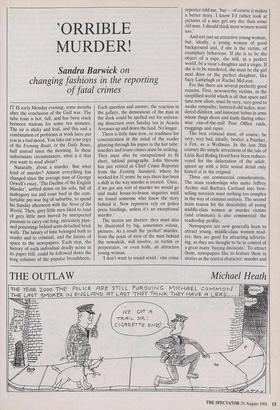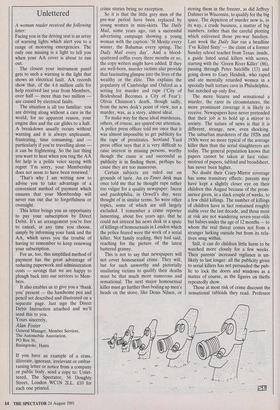'ORRIBLE MURDER!
Sandra Barwick on
changing fashions in the reporting of fatal crimes
IT IS early Monday evening, some months after the conclusion of the Gulf war. The tube train is hot, full, and has been stuck between stations for some ten minutes. The air is sticky and foul, and this and a combination of problems at work have put you in a bad mood. You take out your copy of the Evening Beast, or the Daily Beast, half unread since the morning. In these unfortunate circumstances, what is it that you want to read about?
Naturally, about a murder. But what kind of murder? Almost everything has changed since the average man of George Orwell's essay, 'The Decline of the English Murder', settled down on his sofa, full of mahogany tea and roast beef in the com- fortable pre-war fug of suburbia, to spend his Sunday afternoon with the News of the World. Then, grey little men liked to read of grey little men moved by unexpected passions to carry out long, intricately plan- ned poisonings behind semi-detached brick walls. The luxury of time belonged both to reader and to criminal, and the luxury of space to the newspapers. Each step, the history of each individual deadly scone in its paper frill, could be followed down the long columns of the popular broadsheets.
Each question and answer, the reaction in the gallery, the demeanour of the man in the dock could be spelled out for enliven- ing dissection over Sunday tea in Acacia Avenues up and down the land. No longer.
There is little time now, or readiness for concentration in the mind of the reader glancing through his paper in the hot tube: murders and lesser crimes must be striking. They must also be encapsulated to fit short, tabloid paragraphs. John Stevens has just retired as Chief Crime Reporter from the Evening Standard, where he worked for 31 years: he says there has been a shift in the way murder is treated. 'Once, if we got any sort of murder we would go and make house-to-house inquiries until we found someone who knew the story behind it. Now reporters rely on police press briefings, unless it's an exceptional murder.'
The stories are shorter: they must also be illustrated by big, sometimes colour, pictures. As a result the 'perfect' murder, from the point of view of the man behind the newsdesk, will involve, as victim or perpetrator, or even both, an attractive young woman.
`I don't want to sound sexist,' one crime reporter told me, `but — of course it makes a better story. I know I'd rather look at pictures of a nice girl any day than some old man. I should think most women would too.'
And not just an attractive young woman, but, ideally, a young woman of good background and, if she is the victim, of examplary behaviour. If she is to be the object of a rape, she will, in a perfect world, be a vicar's daughter and a virgin. If she is to be murdered, she must be the girl next door or the perfect daughter, like Suzy Lamplugh or Rachel McLean.
For this there are several perfectly good reasons. First, newsworthy victims, in the simplified world which is all that space and time now allow, must be very, very good to awake sympathy; battered old ladies, mur- dered children, and innocent babes in arms whom thugs shoot and knife during other- wise run-of-the-mill Post Office raids, muggings and rapes.
The best criminal must, of course, be very, very bad, ideally, bestial: a Panther, a Fox, or a Wolfman. In the late 20th century the simple attractions of the tale of Little Red Riding Hood have been redisco- vered for the delectation of the adult, spiced up with a little sexual detail only hinted at in the original.
These are commercial considerations. The mass readerships who make Jeffrey Archer and Barbara Cartland into best- selling novelists want nothing too complex in the way of criminal analysis. The second main reason for the desirability of young middle-class women as murder victims (and criminals) is also commercial: the readership profile.
Newspapers are now generally keen to attract young, middle-class women read- ers: they are good for attracting advertis- ing, as they are thought to be in control of a great many 'buying decisions'. To attract them, newspapers like to feature them in stories as the central character: murder and crime stories being no exception.
So it is that the little grey men of the pre-war period have been replaced by young women in mini-skirts. The Daily Mail, some years ago, ran a successful advertising campaign showing a young woman with the caption: 'St Moritz every winter, the Bahamas every spring. The Daily Mail every day'. And a blood- spattered coffin every three months or so, the copy writers might have added. If they are well-born, murder victims also provide that fascinating glimpse into the lives of the wealthy or the elite. This explains the popularity of Cambridge and Oxford as a setting for murder and rape (`City of Brideshead Becomes a City of Fear'); Olivia Channon's death, though sadly, from the news desk's point of view, not a murder, was, as a story, almost ideal.
To make way for these ideal murderees, others, of course, are spared our attention. A police press officer told me once that it was almost impossible to get publicity for the rape of prostitutes. Scotland Yard press office says that it is very difficult to raise interest in missing persons, worthy though the cause is and successful as publicity is in finding them, perhaps be- cause they are too numerous.
Certain subjects are ruled out on grounds of taste. An ex-Times desk man once told me that he thought rape rather too vulgar for a quality newspaper. Incest and paedophilia, in Orwell's day, were thought of in similar terms. So were other topics, some of which are still largely excluded. I remember a crime reporter lamenting, about five years ago, that he could not interest his news desk in a spate of killings of homosexuals in London which the police feared were the work of a serial killer. Not family reading, they had said, reaching for the picture of the latest battered granny.
This is not to say that newspapers will not cover homosexual crime. They will, but for such unworthy and pictorially unalluring victims to qualify their deaths must be that much more numerous and sensational. The next major homosexual killer must go further than boiling up men's heads on the stove, like Denis Nilsen, or storing them in the freezer, as did Jeffrey Dahmer in Wisconsin, to qualify for the big space. The depiction of murder now is, in its way, a crude business, a matter of big numbers, rather than the careful plotting which enlivened those pre-war Sundays. Last week the Daily Star ran a headline `I've Killed Sixty' — the claim of a former Sunday school teacher from Texas: inside. a guide listed serial killers with scores. starting with the 'Green River Killer' (86), passing through Peter Sutcliffe (13) and going down to Gary Heidnik, who raped and ate mentally retarded women in a specially built torture cave in Philadelphia, but notched up only five.
The more bizarre and sensational a murder, the rarer its circumstances, the more prominent coverage it is likely to receive. Newspapers have never pretended that their job is to hold up a mirror to society. The nature of news is that it is different, strange, new, even shocking. The suburban murderers of the 1920s and 1930s were no more typical of the average killer then than the serial slaughterers are today. The general population knows that papers cannot be taken at face value: mistrust of papers, tabloid and broadsheet, has never been higher.
No doubt their Crazy-Mirror coverage has some transitory effects: parents may have kept a slightly closer eye on their children this August because of the prom- inence given, in a slack couple of weeks, to a few child killings. The number of killings of children have in fact remained roughly stable over the last decade, and those most at risk are not wandering seven-year-olds but babies under the age of 12 months — to whom the real threat comes not from a stranger lurking outside but from its rela- tives snug within.
Still, it can do children little harm to be watched more closely for a few weeks. Their parents' increased vigilance is un- likely to last longer: all the publicity given to serial killers has not persuaded the pub- lic to lock the doors and windows as a matter of course, as the figures on thefts repeatedly show.
Those at most risk of crime discount the sensational tabloids they read. Professor Jock Young, of the Centre of Criminology at Middlesex Polytechnic, says that on bad council estates in the middle of big cities, where most crime takes place, inhabitants have been found to have very accurate ideas of the rates of crime and the age and profile of the typical criminal. They know he is no Wolfman, but the spotty young thug at number seven, who pinches car
radios and breaks into empty houses and fights with the other young thugs, his friends, when drunk. It is the genuine fears of those on these estates which deserve attention and sympathy, not the irrational qualms of those who stoke the fires of their own prejudices with their copy of the Daily Beast, at home on the sofa in safe, late 20th-century suburbia.




















































 Previous page
Previous page